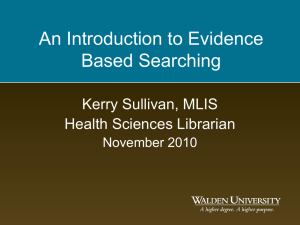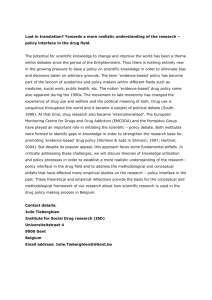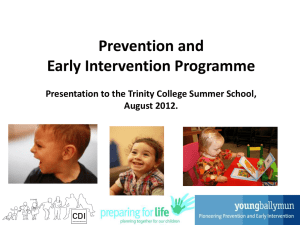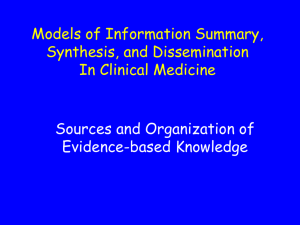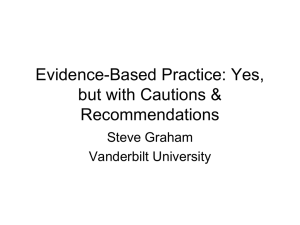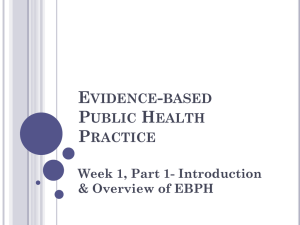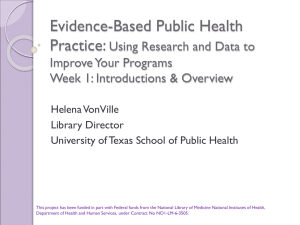uOttawa International Education and Research
advertisement
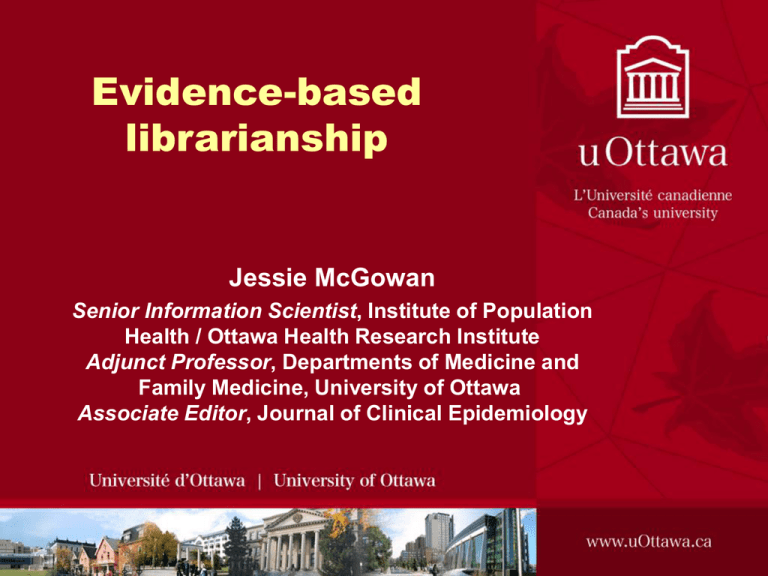
Evidence-based librarianship Jessie McGowan Senior Information Scientist, Institute of Population Health / Ottawa Health Research Institute Adjunct Professor, Departments of Medicine and Family Medicine, University of Ottawa Associate Editor, Journal of Clinical Epidemiology Overview • • • • What is evidence-based stuff? What is evidence-based librarianship (EBL)? EBL examples Knowledge translation (KT) and EBL • Question to ponder: Do we give users what they want or what they need? How does the quality of resource effect collection development policies? Evidence-based history • Evidence-based philosophies integrate a health professional’s experience and knowledge with the best currently available clinical evidence. • It was introduced as EBM by ACP Journal Club in 1991 and this editorial was the impetus for a a series called the Users’ Guides to the Medical Literature in order to help clinician decide how to incorporate these philosophies in to their daily practice. • • Guyatt GH. Evidence-based medicine (editorial). ACP Journal Club suppl 1991;2:A-16. Guyatt GH. Users/ guides to the medical literature (editorial). JAMA 1993;270(17):2096-7. Evidence-based evolution Evidence-based medicine Evidence-based health care, practice, dentistry, nursing etc. Evidence-based medical / health librarianship Evidence-based librarianship Evidence-based approach • • • • • 1. Formation of a clinical question (s) (usually from an existing clinical scenario). It is formed using the following formula of PICO(T): Patient/population Intervention Comparison Outcome Time PICO example In a 41 year-old women with osteoporosis (P), does the use of etidronate (I) versus exercies (C) improve bone density and reduce the risk of fractures (O)? Evidence-based approach 2. A literature search to identify the evidence – Biomedical database searches, textbook searches, grey literature, hand searching etc. 3. Critical Appraisal of the literature search results 4. Application of the results to the patient 5. Quality assurance of the previous steps Evidence-based health librarianship • EBL began with health librarians helping health professionals integrate EBP in their daily practice. Andrew Booth Evidence-based health librarianship Many different roles evolved; – Educators / teachers (involved in curriculum) – Trainers (in use of library applications) – Researchers (methods research) – Collaborators (in grants, systematic reviews) – Information providers (providing expert searching) Evidence-based for all librarianship Now its almost mainstream! There is a CLA Evidence Based Librarianship Interest Group (EBLIG) and a journal Evidence Based Library and Information Practice and an international conference help every two years. "Improve library practice by utilizing the best available evidence combined with a pragmatic perspective developed from working experience in librarianship." Madge, B. Evidence Based Librarianship: Tools we all can use. MLA 2000. Librarianship domains The following six domains and their definitions were developed based upon the major areas librarians deal with in their daily practice*: • Reference/Enquiries—providing service and access to information that meets the needs of library users. • Education—finding teaching methods and strategies to educate users about library resources and how to improve their research skills. • Collections—building a high-quality collection of print and electronic materials that is useful, cost-effective and meets the users needs. • Management—managing people and resources within an organization. • Information access and retrieval—creating better systems and methods for information retrieval and access. • Marketing/Promotion—promoting the profession, the library and its services to both usersand non-users. • Crumly E, Koufogiannakid D. Developing evidence-based librarianship: practical steps for implementation. Health Information and Libraries Journal 2002;19:61–70. Evidence-based librarianship • This is about getting the ‘science’ in information science. Steps in EBL: 1. Define the problem • Formulate a question arising from an issue or problem in a library or in the use of a library based philosophy 2. Find the evidence 3. Critically appraise the evidence 4. Apply the appraised evidence to the problem 5. Quality assurance – evaluate your plan Formulate a question • Let’s think of a few scenarios and questions! Scenario: The quality of bibliographies in the master level theses of music students was noted to be poorer than in other faculties (including poor referencing, low referencing, mistakes, etc.). The Dean of Music raised this issue with the Chief Librarian. The Chief Librarian suggested that perhaps database training could help. Formulate a question The following question was proposed: Does database search training improve the quality of bibilographies in Masters thesis in music students. • Population – Master level music students • Intervention - Database search training • Comparison – Students with no training (maybe use another faculty for comparison) • Outcomes – To improve the quality of bibliographies Search the evidence • What are the sources of information available to librarians? What are specific resources? – Databases – Textbooks – Internet – Unpublished (grey) literature – Expert opinion EVIDENCE PYRAMID http://servers.medlib.hscbklyn.edu/ebm/2100.htm Quality and types of librarian literature • Systematic reviews or Meta-analyses • Randomized controlled trials (RCTs) • Cohort studies - describe possible causal links and pose probabilities of risk • Comparative studies • Descriptive articles (including narrative reviews) • Surveys • Case studies • Qualitative research (such as focus groups, bibliometrics) • Case study: a description of a process, project, program, technology implementation, organization, library service etc. • Cohort study: a study that tracks over time a defined population (the cohort). These groups may or may not be exposed to factors hypothesized to influence the probability of the occurrence of a particular disease or other outcome. Cohorts are defined populations which, as a whole, are followed in an attempt to determine distinguishing subgroup characteristics. • Comparative study: a study that uses a systematic effort to find similarities and differences between two or more observed phenomena. An example could include comparing and contrasting OVID MEDLINE and Pubmed. • Data-mining/ biblio-mining: a method that involves the discovery of meaningful patterns from data retrieved from automated methods. Bibliomining uses the combination of data mining with bibliometrics, statistics, and reporting tools look at patterns in library systems. • Descriptive survey: a survey that describes the respondent perspectives or experiences on the questions that were asked in a predefined manner. Citation analysis represents a variation of the descriptive survey method. • Focus Group: a method that generate data or information from a meeting of individuals. This is also sometimes used to add to information gathered from other research methods such as questionnaires. • Gap analysis: a method involves surveys to identify discrepancies or gaps between individual expectations. • Narrative review (review article): a review or overview of a subject that has been created from the results of an expert literature search. These can provide concise introductions to subjects. • Program evaluation: a method that assesses the operation or outcomes of a program. This can be very valuable in evaluating a program or policy at different levels in their development or implementation. • Randomized controlled trial (RCT): a type of primary research that tests control and treatment groups, where the group participants have been randomly assigned. These trials can use individuals or groups. For example, a study could randomize different libraries to receive an intervention (such as access to certain resource). • Systematic review (Meta-analysis): a review that uses systematic and explicit methods to identify, select and critically appraise relevant research, and to collect and analyze data from the studies that are included in the review. Statistical methods (meta-analysis) may or may not be used to analyze and pool the results of the included studies. Systematic reviews (also known as systematic overviews, evidence summaries and integrative reviews) use recently developed scientific methods to summarize results from multiple research studies. Critical Appraisal • Less is written about critical appraisal in librarianship. It can be difficult for librarians to interpret the evidence. • Journals clubs can be used to improve skills*. Pearce-Smith N. A journal club is an effective tool for assisting librarians in the practice of evidence-based librarianship: a case study. Health Information and Libraries Journal. 2006 Mar; 23(1): 32-40. Application to practice • Now that you asked your question, gathered your evidence, reviewed your evidence, what do you do!!!! Challenges for EBL • Quality of the evidence • Dispersion of evidence sources (e.g., education, management, computer science) • Skills in conducting research • Skills in disseminating research • Skills in interpreting research • Time! Andrew Booth & Anne Brice (http://www.chl.wales.nhs.uk/cpd/librarians/ebased.pdf) EBL Resources Evidence-based Practice for Information Professionals: A Handbook (Hardcover) by Andrew Booth (Editor), Anne Brice (Editor). 2004 ISBN-10: 1856044718 http://www.cla.ca/about/igroups/evidence_based.htm http://ejournals.library.ualberta.ca/index.php/ EBLIP/about/submissions EBL Example - PRESS • PRESS – Peer Review Electronic Search Strategy 1) Develop a quality assessment checklist for electronic search strategies used in HTAs/SRs; 2) Create a web-based peer review forum to these searches. • This project was graciously funded through a grant by CADTH – Canadian Agency for Drugs and Technologies in Health (formally CCOHTA) • The final report to CADTH is complete and an HTA Report is due Dec 2007/Jan 2008. Why? • The quality of Health Technology Assessment (HTA) reports depends on many factors. One factor is the evidence base, the literature and other information, upon which the HTA is based. • Performing a high quality search of information resources ensures accuracy and completeness of the evidence base used in HTA reports. A current review does not exist to tell us what elements of the search process have the most impact in the overall quality of the resulting evidence base. Research Components 1. a systematic review of the literature; 2. a consensus of expert opinion; 3. a peer review forum to evaluate electronic search strategies during the initial stage of a systematic review or health technology assessment Systematic review Systematic searches were performed to identify evidence on the importance of checklist items to the validity of the search. 7 bibliographic databases: • MEDLINE • LISA • CINAHL • The Cochrane Library’s Methodology Register and Methodology Reviews • PsycINFO • HAPI • HealthSTAR 3 in-house databases Systematic review results • A total of almost 9,700 citations were retrieved. Relevancy screening was done by 2 reviewers with the use of SRS, a web-based systematic reviewing platform by TrialStat. • Over 100 relevant articles were obtained. • Although 26 tools were identified that could potentially be used as checklists, none were validated for assessing electronic search strategies. Consensus building - survey • A survey of HTAs/SRs searchers was conducted using Survey Monkey, a web-based survey platform. • Fifty-eight respondents completed the survey and allowed the elements to be ranked into three tiers of importance based on assessment of the potential impact of the elements on recall and precision. Peer review forum • Before programming the interface for a fully operational version of the peer review forum, 10 survey respondents participated in a pilot of a web-based peer review forum in which 10 sample searches. • This was also used for validation testing of the checklist and use of the web-site forum. Implications for Decision Making • Errors in the electronic search strategy have been demonstrated to reduce the effectiveness of electronic search strategies used in systematic reviews and (HTA) reports. Without assurance of a bias-free and complete evidence-base, the true outcomes of a systematic review cannot be tested. A checklist has been developed to assess the electronic search strategy for errors. • An evidence-based peer review process has been developed to evaluate electronic search strategies for use in systematic reviews and health technology assessment reports. Implications for Decision Making • As the evidence base for systematic reviews and HTA reports is created in large part through the electronic search strategy, that strategy should be peer reviewed before the evidence base is created and reviewed. • The evidence-based peer review of search strategies requires the same body of expert knowledge needed to create search strategies; therefore the peer review should be undertaken by librarians or other suitably qualified and experienced individuals. Evidence: the ultimate goal is KT Knowledge translation is the exchange, synthesis and ethically-sound application of researcher findings within a complex system of relationships among researchers and knowledge users. KT • Biomedical research is consistently producing new findings that may contribute to effective and efficient patient care. • The findings of such research will not change population outcomes unless health services and health care professionals adopt them in practice. Grimshaw, Ward, Eccles. Oxford Handbook of Public Health. Audiences for KT in health research Audience Clinical Health Services Population Health +++ +++ +++ Professionals +++ +++ Patients +++ +++ Researchers Basic +++ Administrators Policy Makers Industry ….. +++ +++ +++ +++ +++ +++ +++ What is the librarian’s role? • This is the step beyond dissemination • Current examples include: – Evidence-based actionable messages (EBAMS) – Consumer summaries for Cochrane reviews – Summaries of newspaper articles – Clinical question and answering service Be it Resolved that Evidence – Based Librarianship is NOT Hooey Commentary. Evidence Based Library and Information Practice 2007, 2:2 • It is interesting that librarians, just like physicians, have felt “offended” by being asked to embrace this philosophy. • A few years after the introduction of evidence based medicine in the literature, Sackett et al. replied to all criticisms and verifying that the historical origins date back to mid‐19th century Paris. • This article is now over 20 years old and evidence based medicine is now standard in most medical schools – we need get on with things and catch up! Our question to proponents is, “What is the alternative?” Just make do with what feels good or see what Google has to say? We think not. Sackett, David L., William M. C. Rosenberg, J. A. Muir Gray, R. Brian Haynes, and W. Scott Richardson. “Evidence based medicine: what it is and what it isn’t.” BMJ 312:7023 (1996): 71‐2. Question revisit • Question to ponder: Do we give users what they want or what they need? How does the quality of resource effect collection development policies?
